Knafeh Middle Eastern Pastry
This knafeh recipe is simple to create and intensely scrumptious. Enjoy a classic dessert featuring the crispy texture of kataifi dough with a rich melty cheese layer inside. The whole dish is bathed in sweet floral syrup and topped with crunchy pistachios.

Today’s recipe for knafeh, also spelled kunafa, makes a divinely delicious dessert from the world of Middle Eastern Cuisine. This lavish pastry has been enjoyed for centuries and is prized for its blend of rich melty cheese, crunchy pastry dough, and sweet aromatic syrup.
As exotic as this pastry may seem, my knafeh recipe is actually quite easy to prepare. You’ll only need about 15 minutes of prep time to put this beauty together, and the oven will do the rest. I promise you, this delectable dessert is going to rock your world!

Table of Contents
For more pastry recipes, check out my Easy Greek Baklava, Baklava Rolls, or this Persian Love Cake.

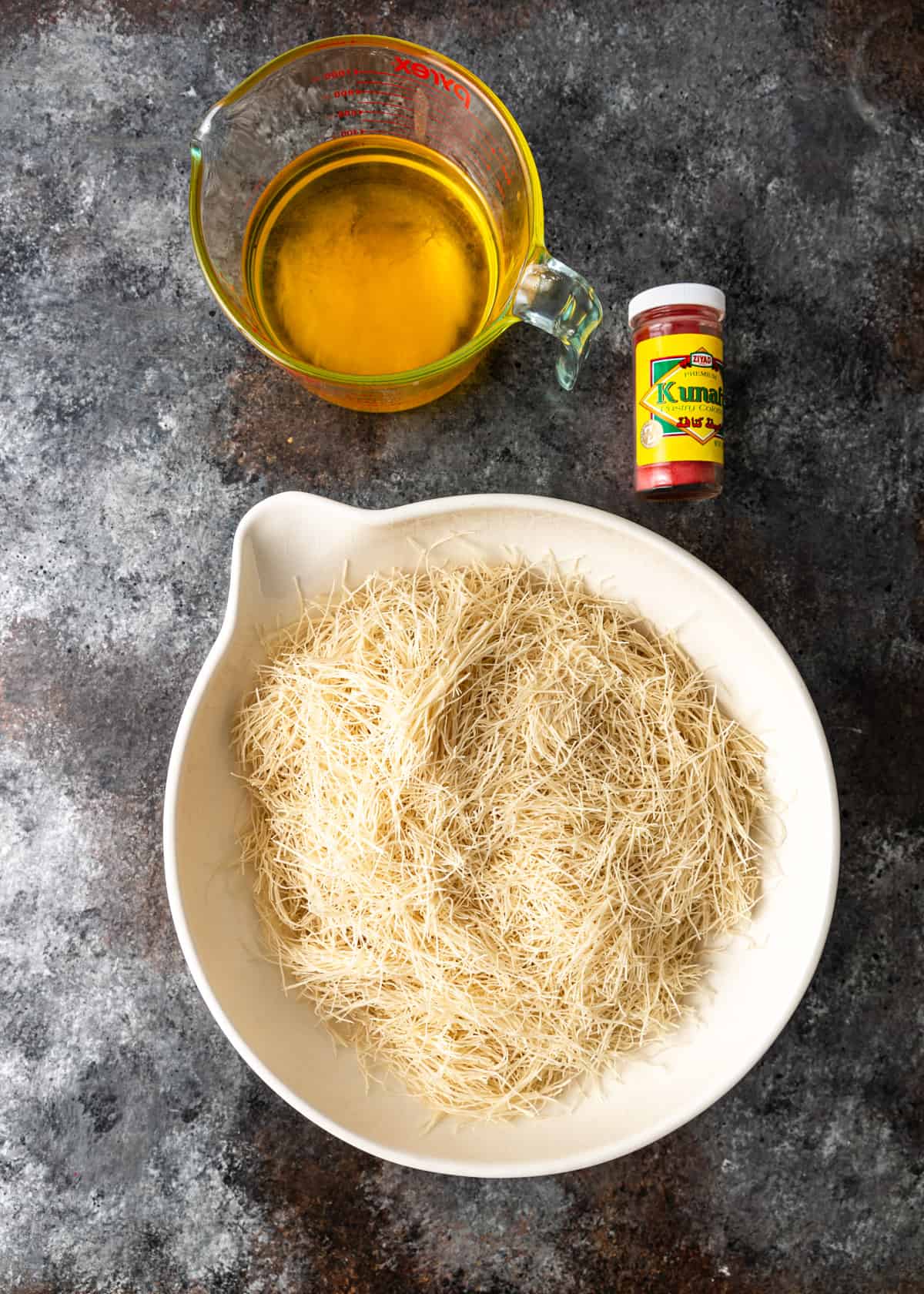
- Kataifi Dough – Look for this unique shredded filo dough in the freezer at your local Middle Eastern market. In a pinch, you can substitute in filo dough.
- Ghee – Adds a sweet, buttery richness and crispness. Regular butter will also do the trick.
- Kunafa Coloring – A powdered type of food coloring made specifically for knafeh recipes. Look for it online, in a Middle Eastern market, or simply skip it, it’s completely optional. Do not try to use regular food coloring.
- Cheese – Traditional recipes call for akkawi cheese which is mild, salty, and sweet. Since this variety can be hard to find in the US, most recipes suggest mozzarella.
- Pistachios – Add a delightfully earthy, nutty crunch to the recipe. Feel free to sub in almonds, walnuts, or your favorite nuts.
- Lemon Juice – Brightens up the syrup with a bit of citrus sunshine.
- Orange Water – Also called orange blossom water, it adds a delicate, floral flavor to the syrup. Look for it in the international foods aisle at the grocery store or a specialty market. Rose water is a great alternative.

A Note on Using Cheese
While you may find adding cheese to this sweet dessert odd, the flavors work wonderfully together! Make sure to use a mild cheese that’s both salty and a bit sweet. As mentioned, if you can’t find traditional akkawi cheese, opt for mozzarella.

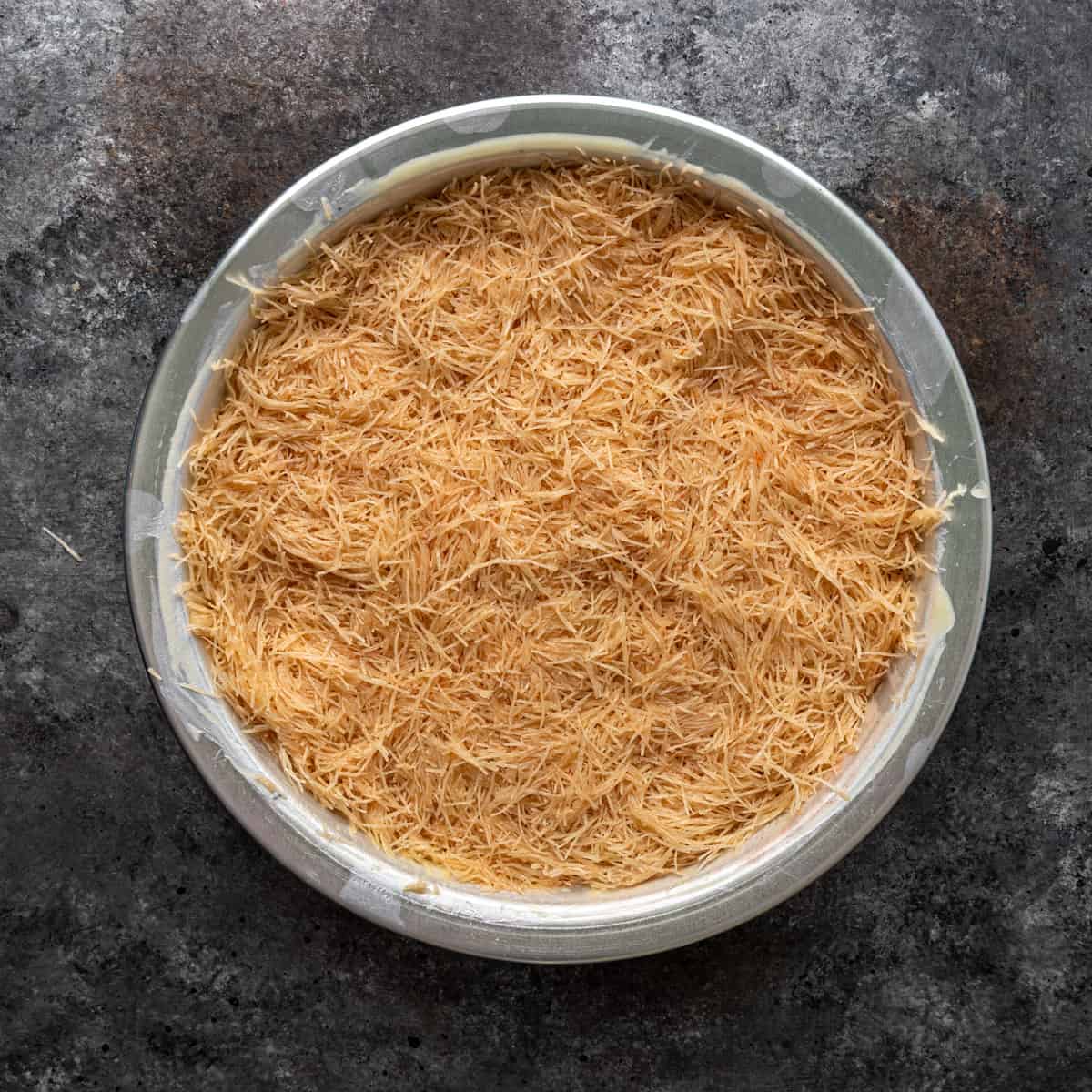
- Prepare the Oven. Preheat your oven to 350 degrees F. Use a tablespoon of ghee or butter to grease the bottom and sides of a 9-inch knafeh, pie, or cake pan.
- Mix in Coloring. (Optional) If working with the kunafa powdered pastry coloring, mix a teaspoon of the coloring into the melted butter or ghee.
- Cut the Dough. Remove any packaging from the kataifi dough. Cut the dough into 1-inch pieces using either kitchen scissors or a knife, then transfer the pieces to a large bowl.
- Coat with Butter. Carefully pour the melted butter or ghee over the dough pieces. Mix thoroughly, but gently, to make sure all the pieces are coated. I recommend using gloves if you are using pastry coloring to avoid staining your skin.
- Start the Layers. Divide the kataifi and transfer one-half of it to the greased baking dish. Press down firmly on the dough using the bottom of a measuring cup or a gloved hand.


- Add the Cheese. Evenly sprinkle the shredded mozzarella or chopped akawai over the dough layer to cover it completely.
- Top with Dough. Evenly distribute the remaining kataifi dough over the top of the cheese layer. Press the layer down gently with your hands. Then, use a butter knife or rubber spatula to press the edges down around the rim.


- Bake the Knafeh. Transfer the pan to the oven to bake for 45 minutes. You want the butter to be bubbling around the edges while the top of the pastry turns a nice golden brown.
- Make the Syrup. Bring the sugar and water to a boil in a small saucepan. Cook for 5 minutes, allowing the mixture to reduce and thicken slightly and then remove the pan from heat. Stir in the lemon juice and orange (or rose) water and set aside to cool.

- Cool & Flip. Take the kunafa out of the oven to cool for 5 minutes. To loosen any stuck parts, run the butter knife or spatula around the rim of the pan. Place a large plate, upside down over the pan. Hold the plate and pan together, carefully flip, and gently remove the pan from the pastry.
- Add Syrup & Nuts. Drizzle half of the syrup over the top of the dessert and sprinkle with the crushed pistachios. Slice and serve warm with extra syrup on the side.

Share this recipe on Pinterest!
Love this recipe? Share it with the world on Pinterest.
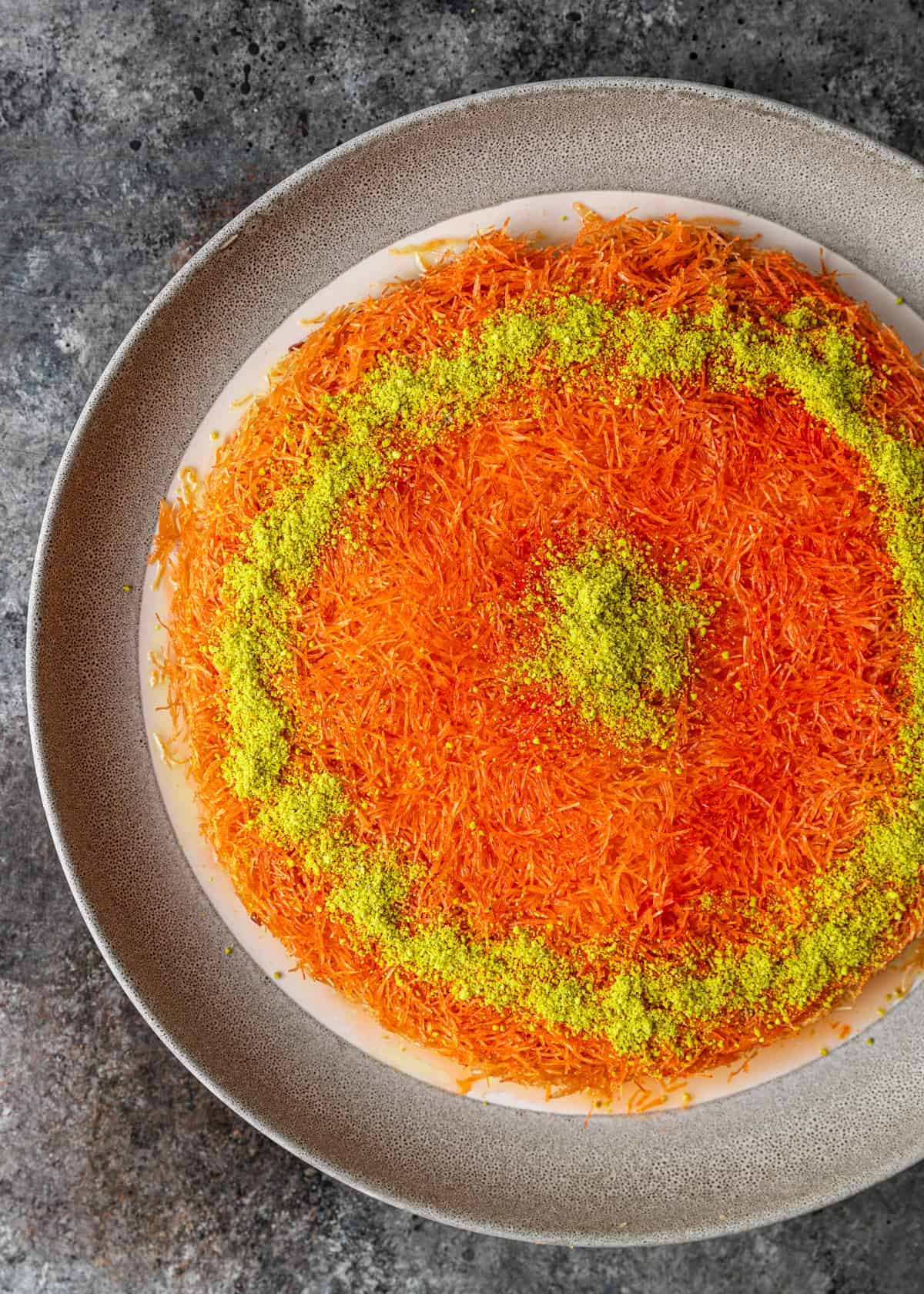
Knafeh and baklava are both traditional desserts that include a flaky pastry dough, chopped nuts, and a sweet syrup. However, they have important differences.
Knafeh is made with a special shredded pastry dough called kataifi. This Middle Eastern gem contains a layer of sweet cheese in between layers of dough. It is baked in a pie pan, often colored, and flipped upside down to serve.
Baklava, on the other hand, is made from standard sheets of filo dough and has no cheese layer. This sweet flaky dish is Turkish in origin and commonly associated with Greece. It is baked on a sheet and cut into squares for serving. The rolled version is called Saragli.
Kunafa origins date back to between the 10th and 15th centuries somewhere in the Middle East. While some debate exists, the most commonly accepted birthplace is the city of Nablus in Palestine.
Yes. Store your freshly made knafeh covered in the refrigerator and consume it within 3 days.
If needed, you can also store your leftovers in an airtight container and freeze for 2-3 months.
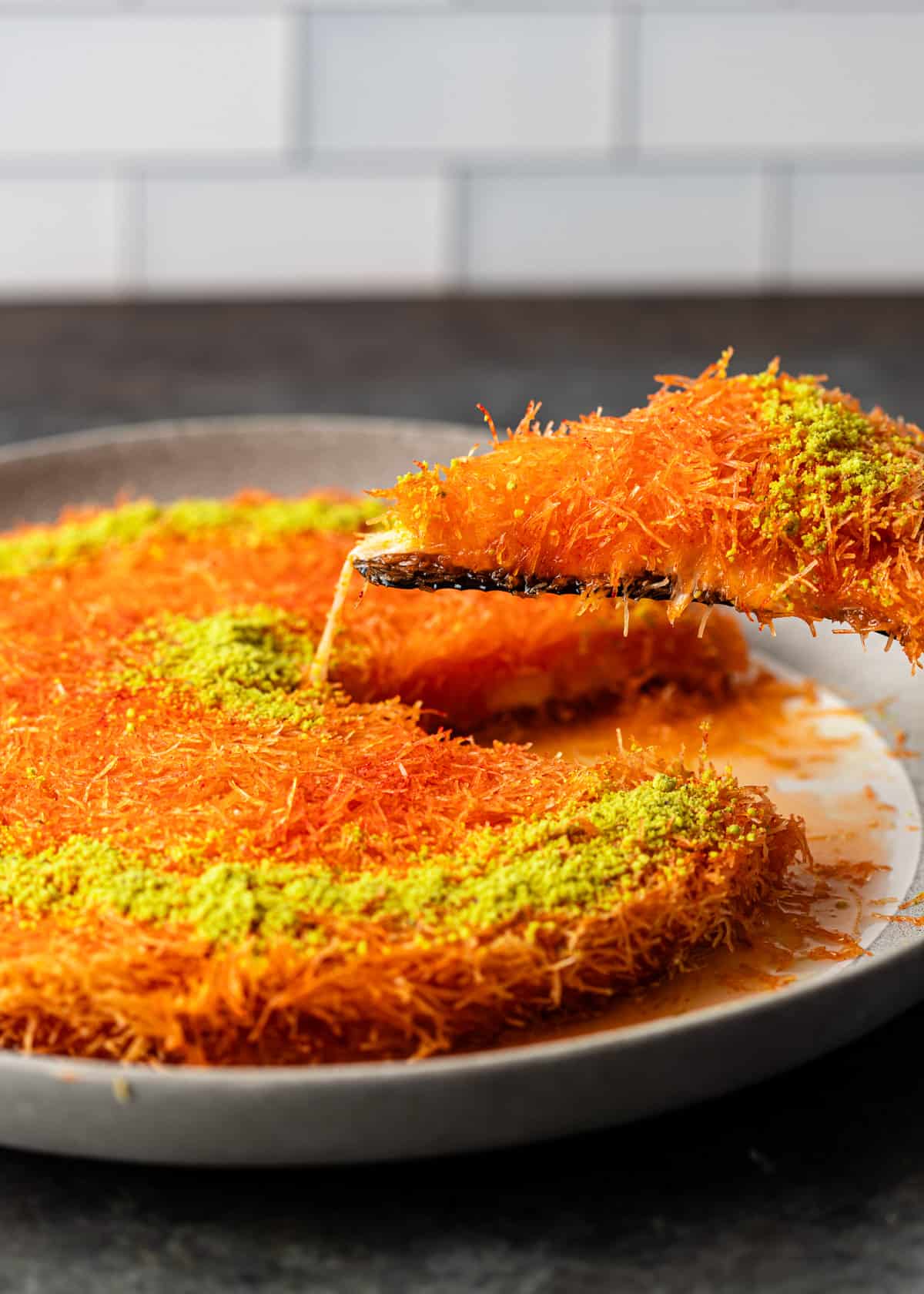

Knafeh Middle Eastern Pastry
Ingredients
- 16 oz Kataifi shredded filo dough
- 1 1/4 cup ghee melted (or butter)
- 1 tsp Kunafa powdered pastry coloring optional
- 16 oz mozzarella shredded, or Akawi Cheese (sweet cheese)
- 1 cup pistachios crushed
Syrup
- 3/4 cup water
- 1 1/2 cups sugar
- 2 tbsp lemon juice
- 1 tsp orange or rose water
Instructions
- Preheat oven to 350°F.
- Mix 1 teaspoon Kunafa powdered pastry coloring, if using, with melted ghee/butter. Grease the bottom and sides of 9-inch knafeh pan, pie pan, or springform cake pan with 1 tablespoon of the ghee/butter and set aside.
- Remove kataifi from the package, place in a large bowl and use scissors to cut into 1-inch pieces or place on cutting board and cut, then place into a large bowl.
- Pour melted ghee/butter over kataifi and mix until all pieces are coated (if using pastry coloring, use gloves), optional.
- Place half of the buttered kataifi into the baking dish, and with gloved hand press firmly to cover, or use the bottom of a measuring cup.
- Sprinkle the mozzarella or chopped akawai cheese and cover the kataifi layer in pan.
- Sprinkle remaining kataifi on top of the cheese and press gently. Using a rubber spatula or butter knife, gently push the kataifi on the edges of the pan down around rim of dish.
- Bake for 45 minutes, or until the top of the knafeh is golden brown and butter is bubbling up the side of the pan.
- While knafeh is baking make the syrup. Add the water and sugar to a small saucepan. Bring to a boil and cook 5 minutes to reduce and thicken slightly. Remove from heat and add the orange (or rose) water and lemon juice. Stir and set aside to cool.
- Remove knafeh from oven and let cool 5 minutes. Run the rubber spatula or butter knife around the edges to loosen any stuck bits and place a larger serving plate on top. Holding both pans, invert and gently lift pan off.
- Pour half of the syrup over the knafeh and sprinkle crushed pistachios in any design pattern you wish on top. Slice and serve with remaining syrup on side, best warm.
Video
Nutrition
The information shown is an estimate provided by an online nutrition calculator. It should not be considered a substitute for a professional nutritionist’s advice.
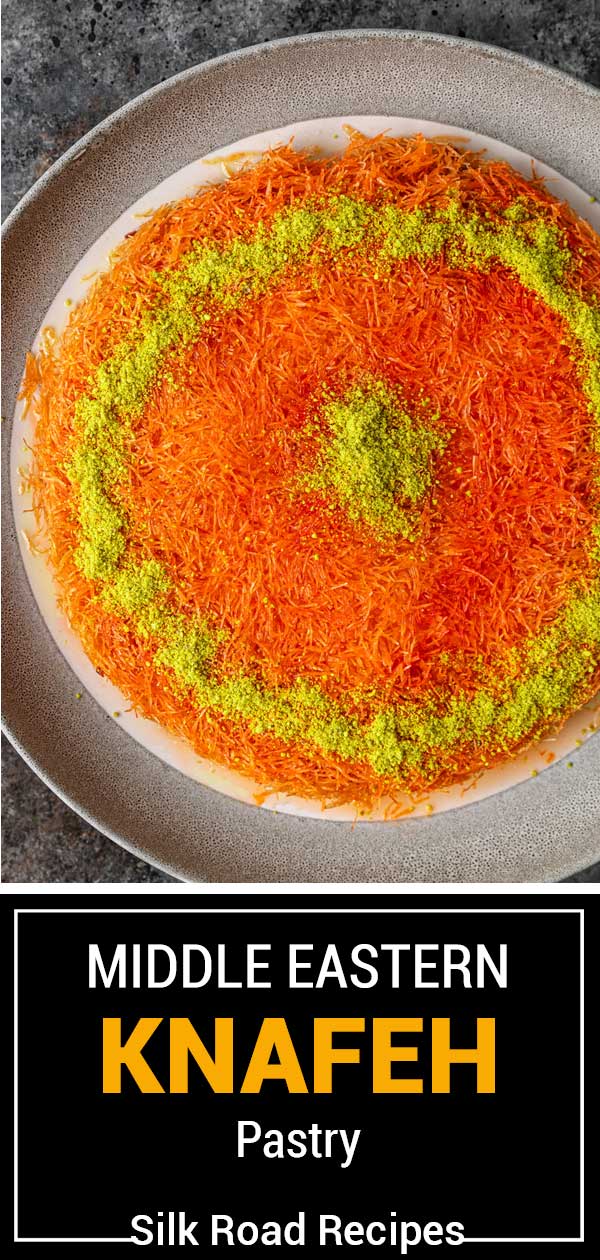

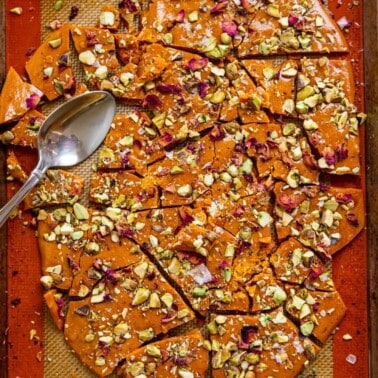
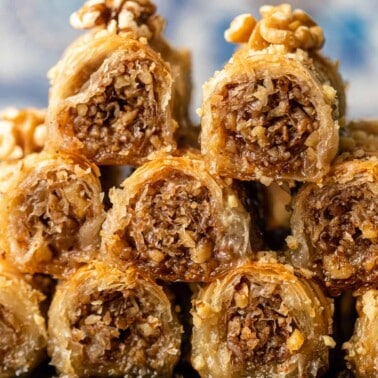
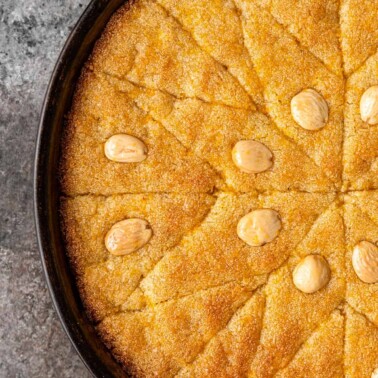
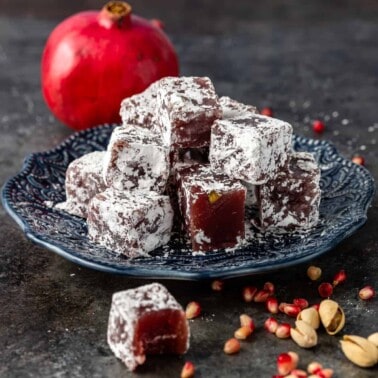








I was super happy when I saw it nd im so gld you enjoy it. Knafeh is very attached to our culture especially celebrations, its like an icon .
it looks Super good, I’m a kanfeh fanatic person, and this looks very Authentic and delicious, The only thing missing i Nabulsi (white sheep/cow cheese), try to get some from middle eastern shop or akawi cheese, I know could be hard to get.. but Enjoy 🙂 and thanks a lot for sharing the recipe.
Hi Farida! Thanks for the cheese tips. After moving up here to the Portland, Oregon area, my go to Middle Eastern markets have become scarce!
It’s super yummy
Thanks for coming back to let me know Sara!
I had a version of this in Jordan while on an archeological dig – it was served fresh, warm, and so yummy! We had it to celebrate one of our local worker’s son’s graduation from secondary school. The whole team loved it! This recipe looks so authentic that I’m going to practice making it and then make I for our team that’s getting back together next month in New Mexico. Thanks so much for posting this recipe!
So happy you’re following along here. It’s a beauty!